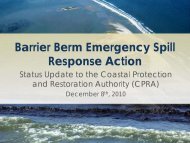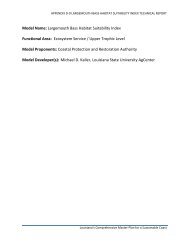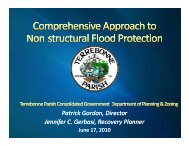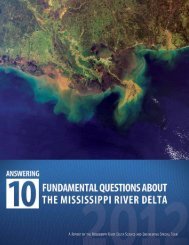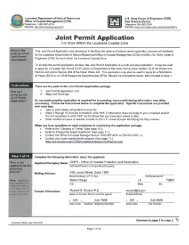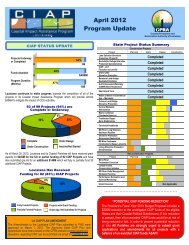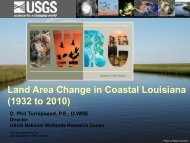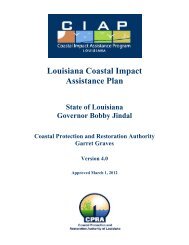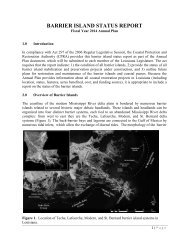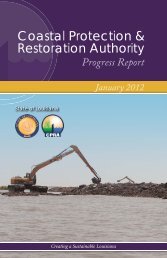Appendix G5a â Public Comments - Coastal Protection and ...
Appendix G5a â Public Comments - Coastal Protection and ...
Appendix G5a â Public Comments - Coastal Protection and ...
Create successful ePaper yourself
Turn your PDF publications into a flip-book with our unique Google optimized e-Paper software.
2005 <strong>and</strong> 2008. This figure should be removed as it has no bearing on the socioeconomics ofl<strong>and</strong> loss <strong>and</strong> coastal Louisianians’ livelihoods.The plan’s Cultural Heritage Decision Criterion assumes people must be near to naturalresources they depend on to retain this heritage; a rudimentary study of coastal Louisiana’shistory <strong>and</strong> its contemporary conditions shows this to be false. As the narrative of <strong>Appendix</strong> J onthis topic demonstrates, coastal Louisianians have time <strong>and</strong> time again shifted their places ofresidence, their spatial relationship to the resources they harvest from the l<strong>and</strong> <strong>and</strong> water <strong>and</strong> theresources they base their livelihoods on; tremendous changes have occurred in all these aspectsover time <strong>and</strong> yet our cultural heritage has survived, modified itself, <strong>and</strong> thrived, with greatefforts to be sure. What commercial fishermen are concerned about, <strong>and</strong> your Fisheries FocusGroup meeting minutes reflect this, is the effect of the plan on the availability of coastalresources, not so much the precise location of them or their proximity to their homes. Manycommercial fishermen move across the coast following the harvesting seasons; people havemoved inl<strong>and</strong> to get away from storm hazards while keeping boats further down or increasingtheir transit times: The problem is making sure that whole categories of resources aren’t wipedout or their productivity severely impaired by the changes in salinity, water quality, or l<strong>and</strong>scapethat this plan <strong>and</strong> ongoing l<strong>and</strong> loss will bring about in the next 50 years. So, in short, treatingone’s proximity to particular natural resources as a proxy for the survival of cultural heritage inSouth Louisiana is not tenable given the historical <strong>and</strong> social scientific evidence. And theresources these coastal communities are said to rely upon in the plan are laughable. On page J-17, we are told that the community of Houma depends on agriculture; even when mygr<strong>and</strong>parents moved here in the 1940s this was largely false, <strong>and</strong> nowadays it’s literally almost ashistorically anachronistic to say Houma is an agriculturally-dependent community as it would beto say New Orleans’ economy depends on paddlewheel riverboats, cotton gins <strong>and</strong> trading slavesin the public markets. It’s obvious to anyone who’s ever been to Houma in the past 40 years thistown is dependent on oil <strong>and</strong> gas; that’s the industry (for better <strong>and</strong> worse) that the town’scultural heritage, which is undoubtedly alive, if not exactly well, depends on. This contradiction–a traditional, ethnic minority culture being preserved, in a somewhat mutated form, throughparticipation in a globalized, rapacious, extractive industry, is well-documented in thesociological literature, but is nowhere reflected in the plan. I could provide other examples formost of the other communities but will spare you here.What is more seriously wrong with the Cultural Heritage Criterion is its playing fast <strong>and</strong> loosewith the numbers on flood risks <strong>and</strong> community identification, bunching up heterogeneouscommunities with greatly differing flood risks <strong>and</strong> then averaging them out so as to arrive atgreater levels of protection than actually exist in the more vulnerable places. This is one of thesimplest ways to lie with statistics: Averaging Mitt Romney <strong>and</strong> a dozen penniless pauperstogether would make them, on the whole, quite wealthy; but while that might mean they shouldpay more than 15% in taxes, it would not mean you’d arrived at an accurate representation of theper capita wealth prevailing in that population. Much the same can be said for how the 50 coastalcommunities / population centers listed in the plan (see page J-16) get grouped into 15community regions that mix highly vulnerable <strong>and</strong> less vulnerable places together <strong>and</strong>, notsurprisingly, raise the overall average of protection on paper while obfuscating the actualsituation that people face now or will face in the future. Your RR calculations are averagedamong communities; it’s unclear if your RI calculations are (<strong>Appendix</strong> B, 7-2 to 7-4) <strong>and</strong> it’s



